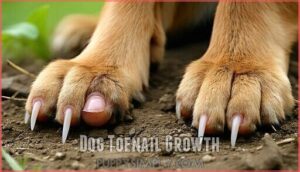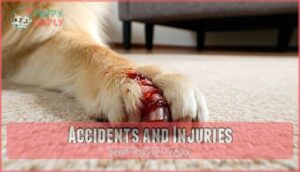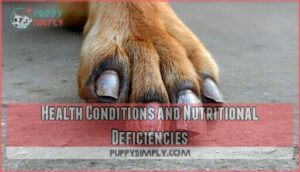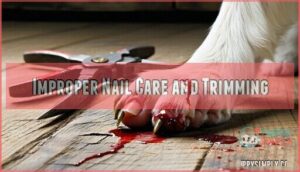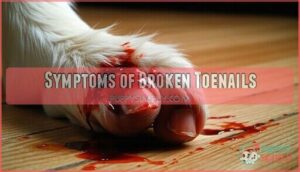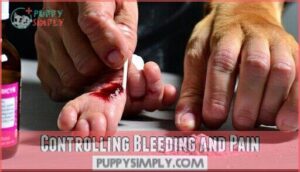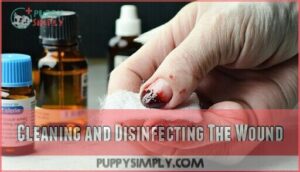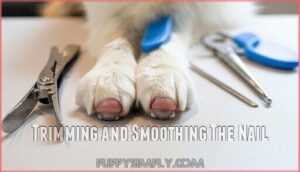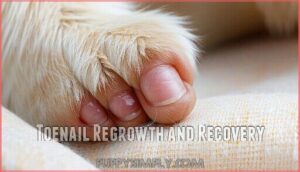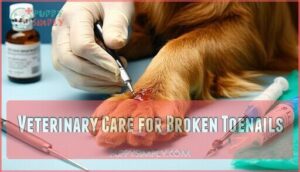This site is supported by our readers. We may earn a commission, at no cost to you, if you purchase through links.
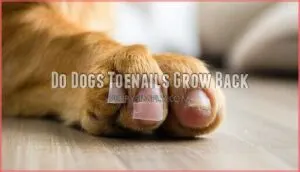 Yes, dogs’ toenails grow back, but only if the nail bed is healthy and undamaged.
Yes, dogs’ toenails grow back, but only if the nail bed is healthy and undamaged.
When a nail gets cracked or lost, it can regrow over weeks to months, much like human nails. However, it might take longer if there’s an injury or infection involved.
Keep an eye out for limping, bleeding, or swelling—these could mean your pup needs extra care or a trip to the vet.
Regular nail trimming and good nutrition can keep their nails strong. Think of it this way: taking care of their nails now saves them (and you) big trouble later.
Curious about regrowth timelines?
Table Of Contents
- Key Takeaways
- Dog Toenail Growth
- Do Dogs Toenails Grow Back
- Causes of Broken Toenails
- Symptoms of Broken Toenails
- Treating Broken Toenails
- Preventing Toenail Breakage
- Toenail Regrowth and Recovery
- Veterinary Care for Broken Toenails
- Maintaining Healthy Toenails
- Frequently Asked Questions (FAQs)
- Will a dog’s ripped out toenail grow back?
- Is it bad for a dog to lose a toenail?
- Will a completely ripped off toenail grow back?
- What happens if you don’t cut your dog’s toenails?
- Will a broken dog nail heal on its own?
- How can I prevent my dog from breaking their nails?
- What are the risks of not treating a broken dog nail?
- Is it necessary to take my dog to the vet for a broken toenail?
- Are there any home remedies I can use to treat a broken toenail?
- How does age impact the rate of nail regrowth?
- Conclusion
Key Takeaways
- If your dog loses a toenail, it will grow back, but the process can take weeks to months depending on the severity and care provided.
- Keeping the nail bed clean, preventing infection, and maintaining a balanced diet with supplements like biotin can support healthy regrowth.
- Regular nail trimming prevents injuries while protecting nails from overgrowth, snags, and cracks that lead to painful breaks.
- Watch for signs of infection like swelling, redness, or discharge and consult your vet for proper treatment if needed.
Dog Toenail Growth
Your dog’s toenails grow continuously, just like your own nails, and they rely on proper care to stay healthy.
The structure is tougher than it seems, but factors like age, activity level, and nutrition can influence how fast they grow, which is a complete concept to consider for their overall health.
Nail Structure and Composition
Dog toenails are fascinating!
Dog toenails are incredible structures, built tough with layers of keratin and a sensitive quick that keeps them growing strong!
Their nail structure includes multiple layers:
- Keratin composition, forming the tough outer shell.
- Nail bed, rich in blood supply that nourishes growth.
- Sensitive quick anatomy, housing nerve endings.
- Protective grooves that shield soft tissue.
- Outer nail plate, ensuring strength and flexibility.
Proper understanding of canine nail anatomy keeps tails wagging and paws healthy!
Factors Affecting Nail Growth
Nail growth depends on several factors, like age and breed predisposition, with active dogs often needing more frequent trims.
A balanced diet boosts nail nutrition, promoting regrowth, while deficiencies or illnesses slow it down.
Think of activity levels as nature’s nail file—regular walks help prevent overgrowth, and some breeds grow nails faster, so keeping up with care is key, especially for active dogs.
Signs of Healthy Toenails
Strong nails with a smooth texture and consistent growth rate are signs of great canine nail health.
Look for a proper length—long enough to protect the paw but not so long they click loudly on hard floors.
Healthy nails are firm, free of cracks, and have a natural, even nail color, which are key indicators of great canine nail health and proper length. Keeping pet nail health of the highest standard avoids painful breakage.
Do Dogs Toenails Grow Back
Lost a nail can feel scary, but don’t sweat it—yes, your dog’s toenails grow back! Nail regrowth depends on factors like nail bed health and post-injury care.
Don’t worry—your dog’s toenails grow back! With care and patience, healthy regrowth ensures those paws stay happy and strong.
On average, the nail regrowth timeline takes a few weeks to months, with complete regeneration possible if the nail bed isn’t severely damaged. Just think of it like waiting for a slow-growing plant to sprout!
To help your canine companion’s nail regrow smoothly, keep the nail bed clean and shield it from infection. It’s also important to recognize that regular grooming can support overall health.
Here’s how to promote healthy recovery:
- Maintain the injured area: Clean gently and bandage as needed.
- Watch for issues: Monitor nail regrowth factors like swelling or unusual discharge.
- Provide good nutrition: A balanced diet supports the dog toenail growth process.
Patience is key!
Causes of Broken Toenails
Broken toenails in dogs usually happen from accidents, health problems, or improper care, so knowing the causes can help you prevent them.
Whether it’s a snag on the carpet or nails weakened by poor nutrition, these issues can lead to painful injuries for your pup.
Accidents and Injuries
Accidents happen, especially when your energetic pup is bounding around.
Snagging hazards like carpets or furniture can easily catch toenails.
Active dogs often face jumping injuries or separation anxiety behaviors, like digging, which lead to breakage.
Stepping accidents or awkward landings also spell trouble.
Quick action supports dog nail injury recovery and promotes healthy nail regeneration.
| Cause | Description | Example | Impact |
|---|---|---|---|
| Snagging Hazards | Nails caught on household objects | Carpets or upholstery | Cracked or broken nails |
| Active Dogs | High-energy activities | Running, jumping, digging | Increased risk of injury |
| Jumping Injuries | Landing awkwardly from heights | Leaping off furniture | Nail bending or splitting |
| Stepping Accidents | Paw stepped or pinched | Accidental door closing | Bleeding or torn toenails |
Health Conditions and Nutritional Deficiencies
Health conditions and nutrient deficiencies can weaken your dog’s nails, making them prone to splits or breaks.
Immune-mediated diseases, cancer effects, and genetic predisposition often lead to nail disorders.
Zinc deficiency, biotin shortages, or infections may also impact nail strength.
These issues can lead to brittle nails that don’t stand up to everyday life, increasing infection risks.
Improper Nail Care and Trimming
Improper nail care can lead to painful breaks.
For effective dog nail trimming, follow these tips:
- Don’t neglect trimming—overgrown nails snag easily.
- Use sharp clippers; dull clippers crush rather than cut.
- Mind dewclaws—ignoring them invites trouble.
Nail trimming frequency varies; aim for every 2-4 weeks.
Avoid clipping too short; learn proper nail trimming techniques to keep your pup comfortable.
Symptoms of Broken Toenails
If your dog has a broken toenail, you might notice limping, bleeding, or constant licking of the paw.
These signs can mean pain or even infection, so it’s essential to act quickly to help your furry friend.
Visible Damage and Bleeding
When your dog hurts a nail, visible damage often reveals itself through nailbed exposure or unexpected nail bleeding.
A little blood might clot quickly, but excessive bleeding severity could hint at deeper wound appearance issues.
Pay attention to the injured dog nail—split or hanging nails might worsen if ignored.
Swift damage assessment guarantees safer healing for your furry friend!
Limping and Pain Response
If your dog’s walking looks off or they’re suddenly limping, pay close attention.
Gait abnormalities often hint at nail pain.
Injuries leave paws sensitive, and they might refuse touch.
Watch for behavioral changes like licking or yelping.
Assess pain severity to guide care.
An injured dog nail can deeply affect movement, highlighting the need for quick attention and proper nail injury pain management.
Infection Signs and Swelling
If your pup’s paw looks red or swollen, smells funky, or has discharge, it’s likely dealing with a nail infection.
Mild swelling or redness could escalate, so keep watch.
Bacterial nail infections may include pus formation—messy, but a clear sign to act.
If swelling severity worsens or you notice abnormal odor detection, consult your vet promptly!
Treating Broken Toenails
Treating a broken toenail might seem tricky, but with the right steps, you can handle it safely.
Start by controlling the bleeding, cleaning the wound, and trimming any sharp edges to prevent further injury.
Controlling Bleeding and Pain
If your dog’s nail bleeding starts after a break, grab some gauze and apply gentle pressure.
Styptic powder or even cornstarch can halt the bleeding quickly. For pain management, consult your vet about appropriate pain medication.
Pressure bandaging helps protect the wound, but persistent bleeding may need vet intervention. Quick attention promotes healing and infection prevention.
Many owners find dog nail styptic helpful for this purpose.
Cleaning and Disinfecting The Wound
After stopping the bleeding, focus on nail wound cleaning to avoid infection.
Use pet-safe antiseptic solutions for nail disinfection, gently washing the area.
Infection prevention starts with thorough wound assessment—check for debris or redness.
For added care, home remedies like warm water with mild soap can help.
Finish with proper bandaging techniques to keep the wound clean and protected.
Trimming and Smoothing The Nail
Precision and care are key to avoiding splits when trimming damaged toenails.
Use proper clipping techniques and opt for quality tools to guarantee safe cuts.
After clipping, smooth edges using filing methods like a nail file to prevent snags.
For best results, follow these steps:
- Select tools suited for dog nails.
- Clip carefully to avoid cutting the quick.
- File edges gently for smoothness.
To further prevent nail issues, consider regular nail trimming for best results.
Preventing Toenail Breakage
You can prevent your dog’s toenails from breaking by keeping them trimmed regularly and ensuring they’re healthy with proper nutrition.
Protect their paws from injuries during play or walks to avoid painful nail damage, focusing on proper nutrition.
Regular Nail Trimming and Care
To prevent nail breakage, keep nails trimmed regularly.
Use dog-specific grooming tools, like clippers or a nail file, and stick to safe techniques.
Here’s a handy guide:
| Task | Frequency |
|---|---|
| Inspect Nails | Weekly |
| Trim Nails | Every 2-8 weeks |
| Smooth Edges | As needed |
| Replace Tools | Annually |
| Seek Pro Help | For tricky nails |
Proper care requires using specialized dog clippers.
Your dog’s nail care matters!
Providing Balanced Nutrition and Supplements
Healthy nails start with proper pet nutrition.
A nail diet rich in quality food prevents nutritional deficiencies that can weaken nail strength.
Dietary impact is significant—omega-3 fatty acids, biotin, or zinc supplements are great options for dog nail regrowth.
Consider additional nail support for ideal results.
Boost food quality, and nail supplements can fill gaps.
Strong nails mean fewer breaks, keeping life stress-free, with the help of proper nutrition.
Protecting Toenails From Accidents and Injuries
After ensuring balanced nutrition, focus on paw protection during playtime.
Safe play and surface awareness can reduce risks—think smooth floors or soft grass instead of gravel.
Nail guards or booties are great for extra nail protection, especially for active pups.
Injury prevention starts with mindful dog nail care and using nail protective measures to avoid painful snags or breaks.
Toenail Regrowth and Recovery
Your dog’s toenails can grow back after an injury, but it’s a gradual process that requires patience and care.
By understanding the factors that affect regrowth and keeping an eye out for progress, you’ll help guarantee a healthy recovery.
Timeline for Toenail Regrowth
The nail regrowth process in dogs depends on factors like the injury’s severity and health status. Typically, regrowth starts within weeks and may take months for complete regrowth.
Nail growth rates vary by breed, and infections can slow things down.
- Mild injuries heal faster.
- Severe cases may take months.
- Health impacts regrowth factors.
- Breed differences affect growth rate.
- Proper nail regrowth care speeds recovery.
The key to successful nail regrowth is understanding that health status plays a crucial role in the process.
Factors Affecting Regrowth and Recovery
Age and regrowth, diet’s impact, blood flow, and paw usage all shape the nail regrowth process.
Younger dogs bounce back faster, while seniors may need extra time. Good nutrition fuels healthy canine nail regrowth, but infection risks can delay recovery.
Active dogs might push the limits, so nail regrowth monitoring matters. To support recovery, fish oil supplements can be beneficial.
Keep wounds clean, and patience pays off!
Signs of Successful Regrowth
When canine nail regrowth is successful, you’ll notice reduced inflammation and a healthy quick appearance.
The new nail growth will resemble the original, showing normal nail shape. Your dog’s movement should improve—no more limping!
Consistently monitor nail regrowth factors like color and texture. With proper nail regrowth protection, you’ll see a steady dog nail growth rate and thriving paws.
Veterinary Care for Broken Toenails
When your dog breaks a toenail, it’s important to seek veterinary care to prevent infection and manage pain effectively.
A veterinarian can safely treat the injury, remove damaged nail portions, and recommend follow-up care to guarantee proper healing.
Diagnosis and Treatment Options
Spotting trouble starts with a vet’s Severity Assessment. They’ll check for pain, infection, and breaks during a dog nail disorders diagnosis.
Diagnostic tests like a urinalysis may catch underlying problems.
Treatment choices depend on the injury:
- Cleaning and trimming the damaged nail.
- Prescription antibiotics to prevent infection.
- Surgical intervention for severe tears.
If your dog is licking its paw, it may be experiencing signs of a break. Quick, accurate care supports healthy dog nail growth rates and prevents further infection.
Pain Management and Medications
Your vet might recommend pain relief options like NSAIDs for dog nail pain, but NSAIDs risks, such as stomach upset, should be considered.
Opioid alternatives or topical anesthetics may also ease chronic pain. For severe cases, nail medication may be prescribed.
Always follow your vet’s advice—you don’t want your pup limping because you skipped nail pain management!
Follow-up Care and Monitoring
Keeping up with nail follow-up care is key. Monitor for infection signs like swelling or discharge, and stick to your pet’s medication schedule.
Regular bandage changes protect healing nails, while activity restriction prevents new injuries.
Schedule regrowth assessments with your vet to track nail growth.
Regular dog nail trimming can help avoid infections.
Ongoing nail monitoring guarantees recovery stays on track—plus, your dog’s paws will thank you for the proper care and regular checks!
Maintaining Healthy Toenails
Keeping your dog’s toenails healthy isn’t hard, but it does take consistency.
By trimming regularly, watching for damage, and providing proper nutrition, you can keep those nails strong and prevent painful problems.
Regular Grooming and Trimming
Regular nail trimming keeps your dog comfy and prevents overgrowth that can lead to injuries.
Use proper tools like pet nail clippers and follow safe grooming techniques.
Aim for trimming every 2-4 weeks, depending on their nail growth.
If your pup squirms, seek professional grooming help—it’s worth it for safer nail care and easier maintenance long term.
Monitoring for Signs of Damage or Infection
Your dog’s nails can’t speak, but their behaviors tell a story.
Keep a sharp eye on swelling indicators, discharge watch, and odor concerns, as these could point to a pet nail infection.
Limping or licking might signal nail injury symptoms.
Early detection through regular nail reassessment helps avoid bigger problems.
Think of it as catching whispers before they become shouts!
Providing a Balanced Diet and Supplements for Nail Health
A well-balanced diet can work wonders for your dog’s nail growth and overall health.
For strong, healthy nails, focus on:
- Omega-3s: Promote glossy nails and reduce inflammation–try salmon or flaxseed oil.
- Biotin Benefits: Support keratin production with eggs or liver.
- Zinc Importance: Boost nail strength using beef or poultry.
Consider nail health supplements if needed!
Regular trims can prevent long term joint issues.
Frequently Asked Questions (FAQs)
Will a dog’s ripped out toenail grow back?
Losing a toenail might feel like losing armor, but don’t worry—your dog’s nail usually grows back in a few months.
Just keep the area clean, follow vet advice, and patience does the rest.
Is it bad for a dog to lose a toenail?
Losing a toenail isn’t ideal, but it’s not catastrophic.
It can hurt and lead to infection if untreated.
Clean the area, watch for signs of infection, and ask your vet for advice if needed.
Will a completely ripped off toenail grow back?
A completely ripped-off toenail will grow back, but it takes several weeks.
During regrowth, keep the area clean, prevent infection, and discourage licking.
Think of it as giving your pup a fresh nail makeover!
What happens if you don’t cut your dog’s toenails?
Neglected nails are like tiny daggers, making walking painful and possibly deforming toes.
Overgrowth can cause cracks, snagging, or even nail bed infections.
Regular trims keep your pup comfortable, avoiding unnecessary pain or injury.
Will a broken dog nail heal on its own?
A broken dog nail can heal on its own if it’s not too severe.
Keep it clean, prevent infection, and monitor for swelling or limping.
Severe breaks, though, might need a vet’s attention.
How can I prevent my dog from breaking their nails?
Imagine nails as tiny soldiers guarding your dog’s health—keep them trimmed regularly, feed a balanced diet, and watch for rough surfaces or sharp edges during play to prevent painful breaks.
Healthy nails, happy pup!
What are the risks of not treating a broken dog nail?
Ignoring a broken nail can lead to infections, swelling, and severe pain.
Your dog may limp, chew the area, or avoid walking altogether.
Left untreated, it risks worsening damage. A quick vet visit avoids complications!
Is it necessary to take my dog to the vet for a broken toenail?
A broken nail might seem minor, but it’s like stepping on a Lego barefoot for your dog.
It’s best to visit the vet to prevent infections, manage pain, and guarantee proper healing.
Are there any home remedies I can use to treat a broken toenail?
You can clean the wound with warm water, stop bleeding using styptic powder or cornstarch, and bandage the area.
Keep your dog calm and prevent licking, but see a vet if pain persists.
How does age impact the rate of nail regrowth?
Aging is like turning down a dial on nail regrowth speed.
Younger dogs grow nails faster due to active cell regeneration, while older dogs often experience slower growth as their metabolism and circulation naturally decline.
Conclusion
Think of your dog’s toenails like a well-tended garden—if the roots (or nail beds) are healthy, those nails will grow back strong.
Yes, dogs’ toenails grow back, but only with proper care.
Keep an eye out for injuries, infections, or unusual limping, and don’t skip regular nail trims and balanced nutrition to maintain healthy regrowth.
When in doubt, consult your vet. A little prevention today saves your pup from painful setbacks tomorrow. Happy paws, happy life!
- https://quote.petinsurer.com/quote/ref=wag?utm_campaign=torn-toenail&utm_content=Condition&utm_medium=web&utm_source=wag&utm_term=content-banner
- https://fearfreepets.com/helping-dogs-with-separation-anxiety/
- http://vetdermclinic.com/
- https://pangovet.com/?utm_source=dogster&utm_medium=article&utm_campaign=dog-nutrition
- https://www.webmd.com/pets/dogs/what-to-do-when-your-dogs-nails-break-or-split

